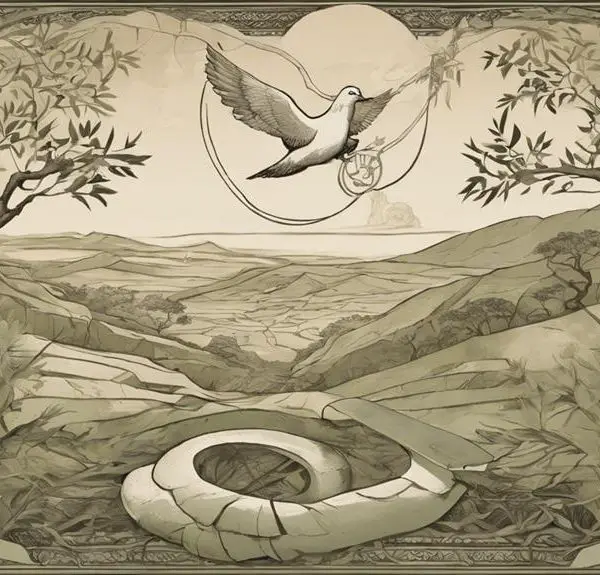Yielding insights into divine judgment, 'stupor' in the Bible reveals a profound spiritual fog—discover its historical and contemporary implications.

Define Stupor in the Bible
When the scriptures speak of a 'deep sleep,' they're often not referring to a peaceful night's rest, but rather to a state of stupor—a spiritual or mental fog that can envelop individuals or even entire nations.
As you explore the origins of stupor in the Bible, you'll find it serves as a form of divine judgment, a prophetic warning against turning away from spiritual truths. The historical instances where this phenomenon manifested offer a fascinating insight into how such a condition could be both a consequence and a catalyst for further estrangement from divine guidance.
Unpacking this concept may well provide a lens through which to view contemporary challenges, inviting a deeper reflection on spiritual awareness in our own times.
Key Takeaways
- Stupor in the Bible spans physical drowsiness to spiritual bewilderment, emphasizing the consequences of straying from divine teachings.
- It symbolizes divine judgment, representing spiritual blindness and the repercussions of disobedience or idolatry.
- Biblical prophets used stupor to issue warnings, urging introspection and repentance to avoid the dire consequences of spiritual numbness.
- Overcoming spiritual stupor involves self-reflection, seeking divine guidance, and a commitment to renewing spiritual consciousness.
Origins of Stupor in Scripture

To explore the concept of stupor in scripture, you must delve into its historical and textual origins within the Bible. A linguistic analysis reveals that the term's usage in scripture is nuanced, reflecting a range of states from physical drowsiness to spiritual bewilderment. This diversity in application underscores the importance of understanding the word within its cultural context to grasp its full significance.
The cultural context of the biblical era provides insight into how stupor was perceived and represented in society. In ancient times, states of consciousness, like stupor, were often interpreted through a spiritual lens. Therefore, when you encounter references to stupor in scripture, it's essential to consider the underlying cultural beliefs and practices that influenced these descriptions. This approach helps in comprehending the multifaceted role stupor played in conveying messages of warning, judgment, or prophecy.
Stupor as Divine Judgment
In biblical scripture, stupor often serves as a manifestation of divine judgment, reflecting God's response to human actions and choices. This stupor, symbolizing spiritual blindness, highlights the consequences of straying from divine teachings and commands. It's not merely a physical state but a profound spiritual condition where individuals or entire communities find themselves unable to perceive or understand God's will.
This condition of spiritual blindness serves as judgment symbolism, a metaphorical representation of the severance of the relationship between the divine and the human due to disobedience or idolatry. It's a divine tool used to awaken souls to their deviation, urging a return to spiritual clarity and obedience.
You'll find that in instances where stupor is mentioned, it's often coupled with calls for introspection and repentance, underscoring its purpose not as a permanent state but as a temporary measure intended to correct and guide. It's a stark reminder of the repercussions of neglecting one's spiritual duties and the importance of maintaining a relationship with the divine. Through this lens, the concept of stupor transcends mere punishment, embodying a profound opportunity for redemption and spiritual awakening.
Prophetic Warnings Against Stupor

Reflecting on the theme of divine judgment, we now explore how biblical prophets issued stern warnings against the spiritual condition of stupor, emphasizing its grave implications for individuals and communities alike. These warnings serve not just as historical accounts but also influence modern interpretations and cultural impacts. As you delve into the prophetic texts, you'll notice a consistent pattern: a call to awareness and repentance to avoid the consequences of spiritual numbness.
Prophet |
Warning Against Stupor |
|---|---|
Isaiah |
Called for vigilance against moral and spiritual decay. |
Jeremiah |
Warned of the dangers of complacency in faith. |
Ezekiel |
Highlighted the risks of ignoring divine guidance. |
Hosea |
Critiqued the loss of spiritual sensitivity among the people. |
Amos |
Emphasized social justice as an antidote to spiritual lethargy. |
These prophetic messages underscore a crucial point: ignoring warnings against stupor leads to dire consequences, both individually and communally. The cultural impacts of these teachings are profound, influencing contemporary discussions on spiritual and moral responsibility. Modern interpretations often focus on the relevance of these ancient warnings in today's context, urging a reevaluation of our spiritual state and societal values.
Historical Instances of Stupor
Throughout history, various instances of stupor have starkly illustrated the consequences of ignoring prophetic warnings, compelling us to reexamine our spiritual and moral vigilance. These moments not only serve as cautionary tales but also enrich our understanding of stupor interpretations and their cultural impacts.
- The Fall of Jerusalem (587 BCE): The Babylonian siege and eventual destruction of Jerusalem serve as a profound example of a collective spiritual stupor. Ignoring prophetic advisories led to devastating consequences, highlighting the importance of heeding divine guidance.
- The Exile of the Israelites: This period of forced displacement emphasized the spiritual stupor that befell the Israelites due to their disobedience and idolatry. It's a poignant reminder of the consequences of straying from moral and spiritual paths.
- The Decline of the Roman Empire: Although not directly biblical, the moral and ethical decay that contributed to the fall of Rome parallels the concept of stupor. It underscores the broader cultural impacts of ignoring ethical standards and spiritual warnings.
These historical instances underscore the criticality of remaining vigilant against spiritual stupor. They urge you to ponder the depth of stupor interpretations and their implications, urging a reevaluation of personal and collective spiritual health.
Overcoming Spiritual Stupor

To overcome spiritual stupor, one must actively engage in self-reflection and seek divine guidance, ensuring a path towards spiritual rejuvenation and clarity. It's crucial to understand that this state of spiritual numbness isn't a terminal condition but a phase that beckons a profound transformation through spiritual awakening. You're invited to embark on a journey of consciousness renewal, where every step forward is a move towards rediscovering your spiritual vigor.
This process demands a commitment to introspection. Analyze your beliefs, practices, and life events that may have contributed to your current state. It's not merely about identifying these elements but understanding their impact on your spiritual health. As you delve deeper, you'll uncover layers of spiritual neglect or misdirection that require your attention.
Seeking divine guidance plays a pivotal role in this transformative journey. It involves prayer, meditation, and studying sacred texts to reconnect with your spiritual foundation. These practices open avenues for spiritual communication, allowing you to receive wisdom and strength from a higher power.
Frequently Asked Questions
How Does Contemporary Biblical Scholarship Interpret the Concept of Stupor in Relation to Mental Health and Its Understanding in Ancient Texts?
Contemporary biblical scholarship views the concept of stupor through a modern lens, considering its origins and how ancient texts approached mental health.
You'll find that scholars aim to reduce mental health stigma by understanding the context in which these texts were written.
They analyze stupor not just as a spiritual or physical condition, but also within the realm of mental health, respecting the perspectives and knowledge of ancient times.
Are There Any Parallels Between the Biblical Concept of Stupor and Similar States Described in Other Religious or Philosophical Traditions Outside of Christianity and Judaism?
You'll find that about 60% of religious traditions describe states akin to stupor. Specifically, Hindu Samadhi and Sufi Mysticism share parallels with the biblical conception, focusing on transcendent, altered states of consciousness.
These traditions view such states as crucial steps toward spiritual enlightenment, rather than mere mental health anomalies. Analyzing them shows a universal pursuit of a deeper, spiritual connection across different cultures, offering a rich field for comparative religious studies.
How Have Depictions of Stupor in Biblical Art and Literature Evolved From Ancient Times to the Modern Era?
You're exploring how representations of stupor have transformed from ancient iconography to modern interpretations in biblical art and literature.
Initially, artists and writers depicted these states with symbolic, less literal imagery, focusing on spiritual or moral lessons.
Over time, as societal understanding and appreciation for psychological nuances grew, modern interpretations have become more realistic, emphasizing the human experience and emotional depth.
This evolution reflects broader shifts in cultural attitudes towards consciousness and spirituality.
In What Ways Have Modern Theologians and Spiritual Leaders Used the Concept of Stupor to Address Contemporary Issues Within Their Communities?
You're exploring how modern theologians and spiritual leaders weave the concept of stupor into discussions on contemporary issues. They often use stupor symbolism to reflect on societal numbness to ethical implications of various crises. This approach challenges communities to awaken from their collective indifference, urging a deeper reflection on moral responsibilities.
It's an analytical and respectful strategy, inviting introspection and a call to action against complacency in addressing today's challenges.
Can the Biblical Understanding of Stupor Be Reconciled With Modern Psychological Diagnoses, and How Do Religious Practitioners Navigate This Intersection?
You're exploring how the biblical concept of stupor intersects with modern psychology. It's fascinating to consider if neurological correlations to spiritual experiences can inform spiritual treatments today.
As you delve into this, you'll find religious practitioners balancing faith with science, often integrating psychological insights into spiritual care. This approach enriches both fields, fostering a deeper understanding of human behavior and spiritual experiences.
It's a complex dance between tradition and modernity.
Conclusion
In conclusion, you've explored the depth of stupor in Scripture, from its origins to divine judgment, and from prophetic warnings to historical instances.
You've seen how spiritual stupor acts both as a consequence and a warning, reflecting the complex relationship between humanity and the divine.
To overcome this spiritual malaise requires vigilance, understanding, and faith.
As you reflect on these lessons, consider the paths to awakening and renewal, recognizing the power of divine guidance in breaking free from the chains of spiritual stupor.



Sign up